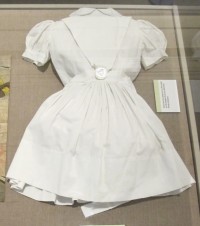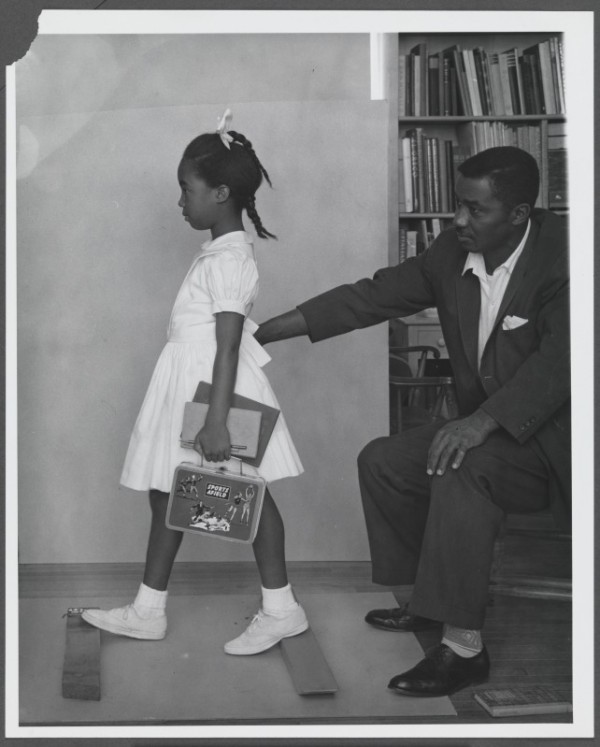Remembering Lynda Jean Gunn

“Problem We All Live With”, 1963 –
Norman Rockwell (1894-1978), Oil on canvas, Illustration for Look, January 14, 1964, Norman Rockwell Museum Collection

Photo of Lynda Gunn
Lynda Jean Gunn (1955 – 2019) of Stockbridge, holds a special place in our hearts. She passed away this week and we would like to share some memories in tribute to her.
In Stockbridge, Lynda is forever immortalized as the model for Norman Rockwell’s painting, the Problem We All Live With (1963, Look Magazine.) This painting is widely attributed as the personal narrative of Ruby Bridges who was the first African American child to integrate the William Franz Elementary School in New Orleans in the aftermath of the Supreme Court ruling – Brown versus Board of Education. Norman Rockwell chose Lynda Gunn of Stockbridge to pose as the model for the painting, as he generally preferred to select local models for producing his paintings.

Photo of Norman Rockwell working on “The Problem We All Live With,” circa 1963. Photo by Louie Lamone. Norman Rockwell Museum Collections. ©Norman Rockwell Family Agency. All rights reserved.
Lynda was the daughter of David and Velma Gunn. She was eight years old when she posed for Norman Rockwell. A descendent of the Gunn family of Stockbridge whose ancestry goes generations deep in the Berkshires, she was one of few African American children living in Stockbridge. Norman Rockwell actually selected two Gunn girls as models, cousins, one six years old and one eight years old, as he worked to pose the girls to reenact Ruby Bridges’ historic walk to school escorted by US Marshalls for her safety in a community that was protesting integrated education.

Reference photo for “New Kids in the Neighborhood”, 1967 – model, Wray Gunn Jr. – Norman Rockwell Museum Collections. ©Norman Rockwell Family Agency. All rights reserved.
Rockwell frequently turned to the Gunns in friendship and for models as was the case in his 1967 story illustration New Kids in the Neighborhood for Look Magazine in which Wray Gunn Jr., Lynda’s cousin, posed for Rockwell as one of the new children moving into a suburban neighborhood.
As often happened, Rockwell selected aspects of several models for his final painting, but studies for the work indicate that he chose Lynda for the final subject. Recently the Museum was fortunate to acquire from Lynda two beautiful portrait studies for the final painting.

Charcoal sketches for “Problem We All Live With”, 1963 – model, Lynda Gunn – Gift of Lynda Jean Gunn – Norman Rockwell Museum Collection
Lynda’s Aunt, Elaine Gunn, who worked at Norman Rockwell Museum for many years, and whose six year old daughter also posed, recalled the story of being asked to make two white dresses for the girls, so that Rockwell could be prepared to choose either girl for his model. The Museum is fortunate to have one of the dresses generously donated to its costume collection, (which includes the suede jacket for Freedom of Speech, the dress for After the Prom, an astronaut suit, and the bikini from Day in the Life of a Little Girl.)

Dress costume for “Problem We All Live With” – Norman Rockwell Museum Collection
Lynda was reticent to share her story with the incessant and at times intrusive media inquiries for interviews with models about their experiences modeling for Norman Rockwell. We respected her desire for privacy yet always knew she held an important piece of history. People often conflate Ruby Bridges to be the model for the painting. We understand Ruby to be the subject, and Lynda to be Norman Rockwell’s model.
Our hearts go out to Lynda’s daughter, Arlyn Traylor, and extended family, many of whom are long-time friends of Norman Rockwell and the Museum. We remember her with love, gratitude and respect for her privacy as a citizen and her special role as a young child for a painting that was to become an icon of the nation. Thank you Lynda for quietly sharing your story and entrusting it and your artworks to Norman Rockwell Museum.

Note from Norman Rockwell to Lynda Gunn under charcoal sketch for “Problem We All Live With”, 1963 – Gift of Lynda Jean Gunn – Norman Rockwell Museum Collection

Reference photo for “Problem We All Live With”, 1963 – Depicting model Lynda Gunn with assistance from her father, David Gunn – Norman Rockwell Museum Collections. ©Norman Rockwell Family Agency. All rights reserved.

Color study for “Problem We All Live With”, 1963 – Portrait of Lynda Gunn – Norman Rockwell (1894-1978), Oil on board, Norman Rockwell Museum Collection

